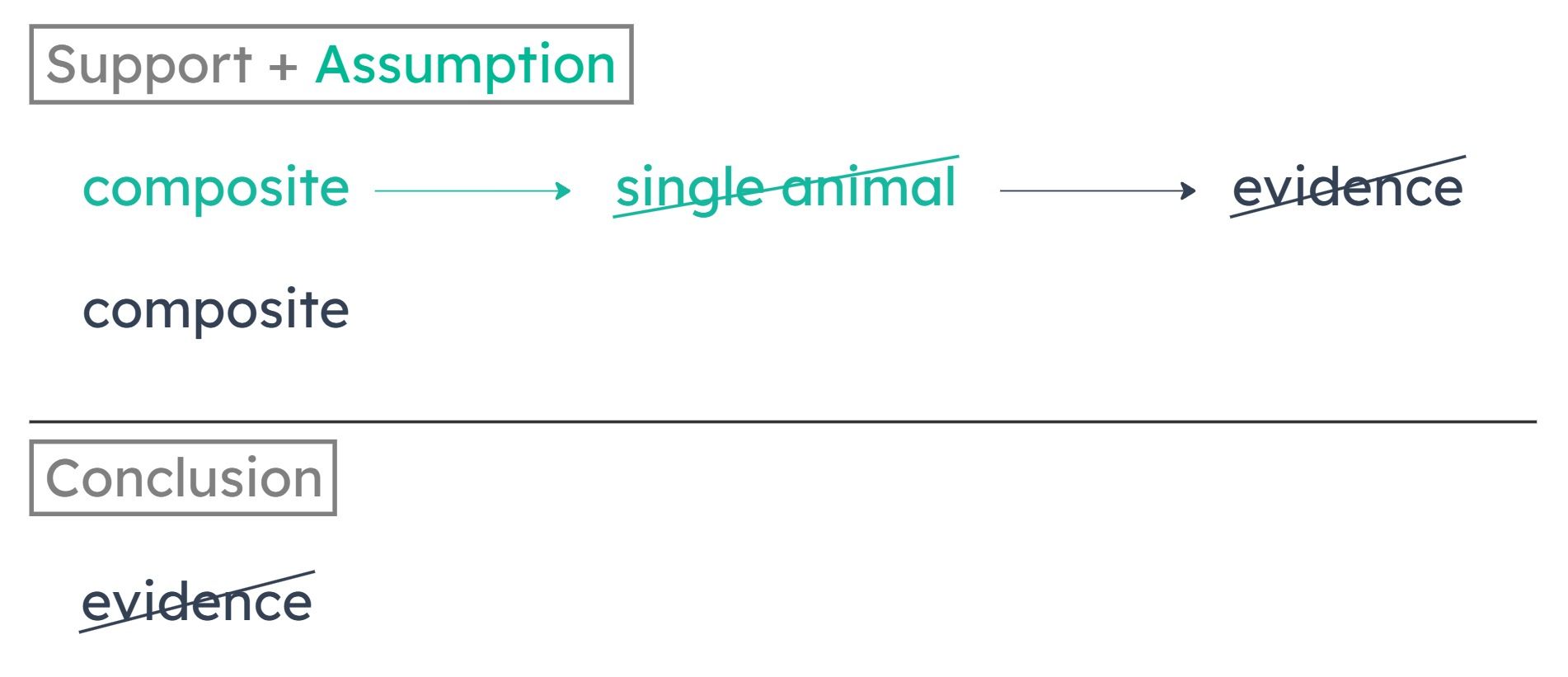LSAT 151 – Section 3 – Question 12
LSAT 151 - Section 3 - Question 12
September 2018You need a full course to see this video. Enroll now and get started in less than a minute.
Target time: 1:04
This is question data from the 7Sage LSAT Scorer. You can score your LSATs, track your results, and analyze your performance with pretty charts and vital statistics - all with a Free Account ← sign up in less than 10 seconds
| Question QuickView |
Type | Tags | Answer Choices |
Curve | Question Difficulty |
Psg/Game/S Difficulty |
Explanation |
|---|---|---|---|---|---|---|---|
| PT151 S3 Q12 |
+LR
| Sufficient assumption +SA Conditional Reasoning +CondR Link Assumption +LinkA | A
1%
147
B
95%
161
C
1%
148
D
3%
153
E
0%
140
|
127 135 143 |
+Easier | 146.292 +SubsectionMedium |
Summary
The author concludes that a recently discovered fossil does not provide evidence that birds evolved from dinosaurs. Why? Because of the following:
In order for a fossil to serve as evidence that birds evolved from dinosaurs, it must be the case that the entire fossil is from a single animal.
But the recently discovered fossil is a compositive of bones collected from different parts of the discovery site.
In order for a fossil to serve as evidence that birds evolved from dinosaurs, it must be the case that the entire fossil is from a single animal.
But the recently discovered fossil is a compositive of bones collected from different parts of the discovery site.

Missing Connection
We know from the first premise that if the fossil isn’t from a single animal, then it isn’t evidence that birds evolved from dinosaurs. But do we have enough to establish that the fossil isn’t from a single animal? No — all we know from the other premise is that the fossil is a composite of bones from different parts of the discovery site. But couldn’t the bones still be from the same animal?
To make the argument valid, then, we want to prove that the fossil is not from the same animal. We can do this by establishing that if the fossil is a composite from different areas of the discovery site, it must come from more than one animal.
To make the argument valid, then, we want to prove that the fossil is not from the same animal. We can do this by establishing that if the fossil is a composite from different areas of the discovery site, it must come from more than one animal.
A
The only paleontologists who believe that the entire fossil is from a single animal are those who were already convinced that birds evolved from dinosaurs.
(A) doesn’t establish that the fossil comes from multiple animals. What scientists believe about the fossil doesn’t establish that it comes from multiple animals.
B
If the fossil is a composite, then it has pieces of more than one animal.
We know from a premise that the fossil is a composite. According to (B), then, it has pieces of more than one animal. Since the fossil isn’t just from a single animal, we can conclude that the fossil cannot serve as evidence that birds evolved from dinosaurs.

C
There are other fossils that provide evidence that birds evolved from dinosaurs.
(C) doesn’t establish that the fossil comes from multiple animals. What is true about other fossils doesn’t prove the origin of this fossil.
D
If the entire fossil is from a single animal, then it is a well-preserved specimen.
We don’t know that the fossil is NOT a well-preserved specimen. So (D) doesn’t establish that the fossil comes from multiple animals.
E
The fossil was stolen from the discovery site and sold by someone who cared much more about personal profit than about the accuracy of the fossil record.
(E) doesn’t establish that the fossil comes from multiple animals.
Take PrepTest
Review Results
LSAT PrepTest 151 Explanations
Section 1 - Reading Comprehension
- Passage 1 – Passage
- Passage 1 – Questions
- Passage 2 – Passage
- Passage 2 – Questions
- Passage 3 – Passage
- Passage 3 – Questions
- Passage 4 – Passage
- Passage 4 – Questions
Section 2 - Logical Reasoning
- Question 01
- Question 02
- Question 03
- Question 04
- Question 05
- Question 06
- Question 07
- Question 08
- Question 09
- Question 10
- Question 11
- Question 12
- Question 13
- Question 14
- Question 15
- Question 16
- Question 17
- Question 18
- Question 19
- Question 20
- Question 21
- Question 22
- Question 23
- Question 24
- Question 25
- Question 26
Section 3 - Logical Reasoning
- Question 01
- Question 02
- Question 03
- Question 04
- Question 05
- Question 06
- Question 07
- Question 08
- Question 09
- Question 10
- Question 11
- Question 12
- Question 13
- Question 14
- Question 15
- Question 16
- Question 17
- Question 18
- Question 19
- Question 20
- Question 21
- Question 22
- Question 23
- Question 24
- Question 25
Leave a Reply
You must be logged in to post a comment. You can get a free account here.